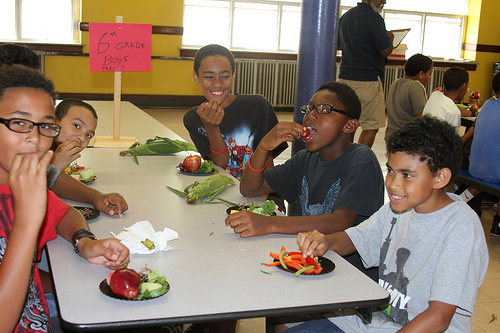
On J.A. Ranch pastures, cattle are rotated to maintain a stubble height of six inches or greater in a three- to four-pasture rotation system.
James K. “Rooter” Brite, Jr. is a born-to-the-land Texas rancher and participant in USDA’s Natural Resources Conservation Service (NRCS) conservation programs.
Brite was born and raised on the ranch his grandfather, J.A. Brite, purchased in 1929, near Bowie, Texas. These days he runs more than 850 cows and yearlings on 3,400 acres of shallow, rocky soils, tall grass prairie and post oak cross timber in an area that receives less than 30 inches of rainfall annually. Read more »

Crow Creek Fresh Food Initiative employee Wyatt Fleury at the Farmer’s Market with Kevin Yellow Bird Steele. With USDA support, a Farmers market is thriving in Ft. Thompson.
Hunkpati Investments, Inc., serving the Crow Creek Reservation in Fort Thompson, South Dakota offered the visiting South Dakota USDA Rural Development State Director, Elsie M. Meeks and others, a tour of their new facility and an opportunity to buy fresh local produce at their farmer’s market. Read more »
USDA’s Food and Nutrition Service (FNS) recently released its 2009-10 School Food Purchase Study, which provides national estimates of the quantity, value and unit price of food acquisitions by school districts participating in the National School Lunch and School Breakfast programs. This year, the Survey for the first time asked specifically if school districts were purchasing local food and included questions about the total value of purchases and the major items purchased.
School district responses provide an important baseline for tracking the national progress of local food purchases by school food service programs. The responses showed that about 2 out of every 10 school districts surveyed purchased local produce for school meals during the 2009-10 school year, based on responses from a nationally representative sample of 416 school district food service directors about practices for purchasing food for school meal programs. An additional 12 percent indicated that they are in the process of developing a program for buying locally grown produce. Read more »

Fruit and Veggie Ambassadors sampling fresh fruit and vegetables at a Pawtucket Summer Food Service Program.
Do you know what a Malanga is? What about a Chocolate Pepper? The “Fruit and Vegetable Ambassador ” (F&V Ambassador) students of Slater Jr. High School in Pawtucket, Rhode Island learned about these unusual vegetables and more during their Summer Food Service Program fruit and vegetable taste testing. For the less adventurous vegetable eater, a Malanga is a root vegetable that has a nutlike flavor and when cut open looks similar to a sweet potato. A Chocolate Pepper is a purple Bell Pepper.
The students at this summer food program are nicknamed the “F&V Ambassadors” of their school. Along with this prestigious title, students get cool t-shirts and, most importantly, the responsibility of encouraging fellow students throughout the school year to make healthier decisions at lunchtime. Read more »



